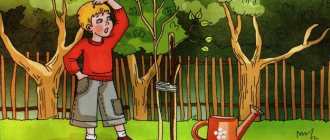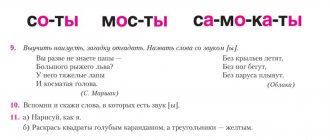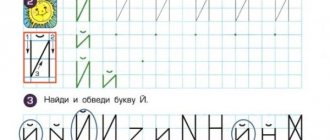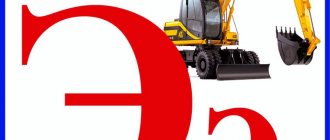Games and exercises to prepare for teaching literacy to children of senior preschool age
Transcript
1 Games and exercises to prepare for teaching literacy to children of senior preschool age p/n Name of the game Contents 1 “Guess the sound by silent articulation” A) The teacher silently articulates a vowel sound and asks the children to determine what sound it articulates and repeat it as many times as possible. How long will the teacher clap his hands? B) The teacher silently articulates the 2nd vowel sound (for example, AU, the children determine what sounds he articulates and repeat after the teacher as many times as the teacher shows fingers. 2 “Repeat the vowels” The teacher pronounces the vowel sound and asks the children to repeat after it, and then show what sound signal it is indicated by. 3 “Which sound is repeated more often?” 4 “Repeat, observing the rhythmic pattern” 5 “What sound is heard at the end of words?” 6 “Match the vowels to the diagram” 7 “Match the pictures to the diagrams” 8 “Come up with words for the diagrams” 9 “Isolating a vowel sound by ear from a number of vowels” The teacher says: “I will pronounce different vowel sounds, and you listen to which sound is repeated more often than others.” Then, the teacher asks to name this sound and pronounce it as many times as possible. times, how many counting sticks the teacher will place on the table. The teacher repeats the same vowel sound three times, highlighting it in the initial, middle and final positions (for example: a-a-a, A-a-a, a-a-a ), children must repeat after the teacher, observing the rhythmic pattern. The teacher pronounces a series of words that end in the same sound (for example: cats, gardens, bridges) and asks the children to identify this sound and indicate its place in the words on the diagram. The teacher shows the children sound patterns (two or three red circles standing next to each other) and asks the children to come up with a combination of sounds according to the pattern (for example: AU, IAO, UAO). The children have object pictures on their tables. The teacher distributes diagrams where the vowel sound is indicated at the beginning, middle and end of the word, asks the children to match the pictures to the diagrams and name them. The teacher distributes diagrams where the vowel sound is indicated at the beginning of the word (in the middle, at the end) and asks the children to come up with words for the given diagrams. The speech therapist pronounces vowel sounds, alternating them incorrectly (a, u, y, u, i, a, u, etc.). The instructions are given as follows: “You must raise your hand (or clap your hands) if I say the sound y.” 10 “Make a sound” Children are asked to say the word duck; their attention is drawn to the fact that the first sound in this word is y. The teacher says: “Listen to what I say and look at my lips.” Then he pronounces the word duck two or three times, emphasizing the intonation sound u. Then the speech therapist continues: “In this word
2 11 “Say words starting with the sound A or U,” the first sound is u. Let’s say this word again all together.” Similarly, the sound y stands out from 2 3 more words (ear, Ulya, snail). This time the children are asked to identify the sound y from the beginning of the word themselves. There are pictures on the table. The called child takes one of the pictures, clearly pronounces the name of the object depicted on it, then names the first sound. Example words: Alik, Anya, duck, album, street, car, ear, antenna. All children are tasked with carefully monitoring the correct answers of their comrades. 12 “Learn the sound” Speech therapist: “Now we will repeat the sounds that we have already taught. Guess for yourself what sounds these are. The speech therapist silently articulates. Children look carefully and name the sounds: a, u, i, e. 13 “How many sounds do you hear?” 14 “Add the last sound” As directed by the speech therapist, individual children, clearly articulating, pronounce the indicated sounds and use pictures to select words starting with these sounds (Alik, duck, snail, Ivan, Inna, echo, willow, etc.). At the request of the teacher, individual children or all together pronounce various combinations of the indicated sounds (ai; ui; ua, etc.). Each time the number and sequence of sounds in combination is determined. If there are difficulties, the speech therapist draws the children’s attention to articulation. When addressing children, the speech therapist pronounces the word pau without the last sound, while simultaneously showing a picture; the child must pronounce the last sound (k), and then the whole word (spider). 15 “Indicate the sound with a signal” 16 “How many times will you hear the sound?” The teacher names the sound and asks the children to remember how it is designated, and then pronounce it as many times as the teacher claps his hands. The teacher reads a pure saying, the children must count how many times a given sound is repeated and pronounce it the same number of times (for example: Sa Sa Sa was bitten on the nose by a wasp. The sound C is pronounced 6 times.)
3 Games for teaching syllabic analysis and synthesis to children of senior preschool age n/p Name of the game Contents 1 “Hard soft” Children stand in a circle. It is proposed to pronounce syllables alternately, either with a hard or a soft consonant (syllables are given only with the vowel a), i.e. if the first child pronounces the syllable pya, then the second pah, then pya again, etc. The consonant sound changes from time to time. The speech therapist says, turning to one of the children: “Now tell me.” The next child must say me, etc., until there is another task. 2 “Come up with a name” The speech therapist throws the ball and says the first syllable of the beginning of the name of a boy or girl. The child must complete the word so that the second syllable has a soft sound. Approximate names: Valya, Vanya, Vasya, Kolya, Lelya, Lenya, Manya, Panya, Tanya, Lyusya, Dusya. 3 “Repeat the syllable and make a diagram for it” The teacher pronounces several syllables and asks the children to repeat and make a sound diagram for them. Examples of chains of syllables: that, that, you; at, from, ut. 4 “Add a syllable” The teacher pronounces the syllables and asks the children to add a certain syllable to them and name the resulting word. For example: MA. (sha - Masha, ma - mother, ki maki). 5 “Repeat the syllables, observing the rhythmic pattern.” The teacher pronounces three identical syllables with a given sound, highlighting one of them. Children repeat after the teacher, observing the rhythmic pattern (NA na na, na NA na, na na NA). As the task becomes more complex, open and closed syllables can be used, and the vowels in words can change. 6 “Name the syllable for the pattern” The teacher shows the children sound patterns of syllables made of two and three sounds and asks the children to come up with syllables for these patterns. 7 “What sound is repeated?” The teacher names a chain of syllables in which one syllable is the same. For example: bark hole hole hurray. Children identify a repeating syllable and make a diagram of it. 8 “Who is more attentive?” The teacher shows the children object pictures whose names contain a given sound, and names them. Children must determine which sound occurs in all words. Then, the teacher removes the pictures and asks the children to remember all the spoken words, and also come up with words with the given sound. 9 “Repeat the words” The teacher names from 2 to 5 words, throws the ball to the child. The child must remember and pronounce the words clearly. 10 “Indicate the place of the sound. The teacher pronounces several words in which
4 in the word" 11 "Match the picture to the diagram" the sound being studied is heard at the beginning (middle, end) of the word. For example: raspberries, mask, milk, brands. The child must identify and name the sound and determine its place in the word. The children have diagrams laid out on their tables, where the sound is indicated at the beginning (middle, end) of the word. And subject pictures. The teacher asks to arrange the pictures so that their names correspond to the diagrams. The teacher asks the children to come up with words with the given sounds for the sound pattern. 12 “Come up with words for the sound pattern” 13 “Enchanted word” There are object pictures on the board. Children must name each picture, identify the first sounds from the words and form a word from them. The teacher asks the children to say the word as many times as there are syllables in it. 14 “Repeat, don’t make a mistake” Repeating after the teacher combinations of two or three syllables like: mu tu; ut uk, etc. This exercise is conducted as an attention game. After two or three children repeat the proposed syllable series, a new combination is given. A very clear pronunciation of every syllable, every sound is constantly required. 15 “Change the word pattern” The teacher names the word (cat). Children lay out the sound pattern of the word. The teacher asks: “How will this scheme change if we say not “cat”, but “cats?” Children answer that instead of three sounds, a fourth sound appeared in the word. 16 “Pronounce the syllables” The speech therapist says: “The one who correctly pronounces what I say will sit.” The speech therapist pronounces combinations of two or three syllables, including any of the soft consonant sounds available for pronunciation, for example: li la; wow me nya. 17 “Find a place for your picture” Each child has an object picture. Children need to place pictures on the board while simultaneously naming them and determining the number of syllables. 18 “Choose pictures” A number of pictures are displayed on the board. Children need to choose pictures whose names consist of 2 (3, 4) syllables. 19 “Shop” Various objects are placed on the table, the names of which can be pronounced by children and, if possible, contain the sounds s and s; one of the children is the “buyer” - approaches the table, the “seller” - the speech therapist offers him a choice of three toys, the names of which consist of one, two or three syllables. The child chooses a toy and claps the rhythm of the word denoting it. Children must guess what toy the buyer wants to buy. 20 “One, two, three” Children select pictures whose names contain a certain number of syllables (one, two, three).
5 One of the exercises is held as a competition. Children line up in two lines. The speech therapist hits the tambourine one, two or three times. The next pair of competitors must quickly come up with a word (from among those that are correctly pronounced) with the appropriate number of syllables.




